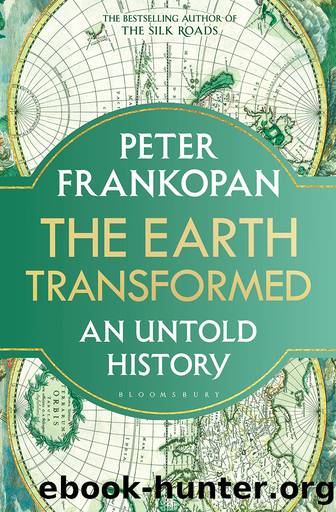The Earth Transformed by Peter Frankopan

Author:Peter Frankopan
Language: eng
Format: epub, pdf
Publisher: Bloomsbury Publishing
Published: 2023-03-15T00:00:00+00:00
20
The Age of Turbulence
(c.1870âc.1920)
A gallant body of Englishmen have fallen victim to their efforts to bring West Africa within the outer fringes at least of civilisation.
Daily Telegraph (18 January1897)
If the human consequences of disaster were severe and shocking, so too were the ecological implications of rapid transformations of landscapes that were motivated by the chase for a fast buck. For example, forests were hacked down to create cotton plantations. This had obvious knock-on effects for flora and fauna alike, exacerbated by the practice of paying bounties for tigers, panthers, wolves, bears and hyenas â apex predators whose disappearance produced major environmental change. Worse, land that was cleared often proved to be unsuitable or was exploited so badly that yields dried up, as (literally) did rivers, lakes and water resources as a result of soil erosion or because clearances induced changes to regional rainfall patterns.1
The story of cotton was one that was repeated time and again, particularly from the second half of the nineteenth century onwards when global markets became more integrated, transport networks improved and information-sharing accelerated. For example, the demand for rubber shot up as a result of Charles Goodyearâs pioneering work in the 1830s on vulcanisation, the chemical process that improves elasticity, hardness and resilience, and then again by the development of the pneumatic tyre, perfected by John Dunlop in 1888.2
Rubber production rose in leaps and bounds from around 2,500 metric tons in 1851 to over 20,000 tons thirty years later. That was just the start of it. By 1900, some 50,000 tons was being produced; by the eve of the First World War, it was closer to 120,000 tons. During this time, rubber became âthe most important, most market-sensitive, most sought-after new commodity in the worldâ, much in demand for bicycles and cars, as well as for a seemingly limitless new range of goods and products, from shoe soles to electrical insulation.3
This versatility too spurred a rush to alter the use of land and take advantage of the demands â and profits â on offer. The rate of transformation was not so much bewildering as epic. Vast amounts of rainforest in South-East Asia were cut down and replanted with Hevea seeds from the Amazon. In the late 1890s, around 145 hectares had been planted in Melaka and Selangor, in the Malay peninsula. By 1910, that had risen to around 220,000 hectares, with plantations being established in other states too, such as Perak. Four years later, more than 445,000 hectares had been cleared for rubber-plant cultivation. By 1914, more rubber was being exported from the Malay peninsula than all of South America combined. The Dutch East Indies followed the same pattern, with large-scale planting in the same period resulting in rubber trees covering 245,000 hectares in 1914 and almost double that amount five years later. By the 1930s, millions of hectares of the worldâs richest rainforests had been replaced by rubber trees by entrepreneurs who recognised that cheap land could be the basis of great fortunes, especially once cars began to be mass-produced and demand for rubber for tyres soared even more.
Download
This site does not store any files on its server. We only index and link to content provided by other sites. Please contact the content providers to delete copyright contents if any and email us, we'll remove relevant links or contents immediately.
Man-made Catastrophes and Risk Information Concealment by Dmitry Chernov & Didier Sornette(5647)
The Revenge of Geography: What the Map Tells Us About Coming Conflicts and the Battle Against Fate by Kaplan Robert D(3961)
Zero Waste Home by Bea Johnson(3655)
In a Sunburned Country by Bill Bryson(3365)
COSMOS by Carl Sagan(3346)
Good by S. Walden(3345)
The Fate of Rome: Climate, Disease, and the End of an Empire (The Princeton History of the Ancient World) by Kyle Harper(2870)
Camino Island by John Grisham(2719)
A Wilder Time by William E. Glassley(2689)
Organic Mushroom Farming and Mycoremediation by Tradd Cotter(2565)
The Ogre by Doug Scott(2501)
Human Dynamics Research in Smart and Connected Communities by Shih-Lung Shaw & Daniel Sui(2431)
Energy Myths and Realities by Vaclav Smil(2380)
The Traveler's Gift by Andy Andrews(2299)
9781803241661-PYTHON FOR ARCGIS PRO by Unknown(2268)
Inside the Middle East by Avi Melamed(2230)
Birds of New Guinea by Pratt Thane K.; Beehler Bruce M.; Anderton John C(2175)
A History of Warfare by John Keegan(2104)
Ultimate Navigation Manual by Lyle Brotherton(2048)
